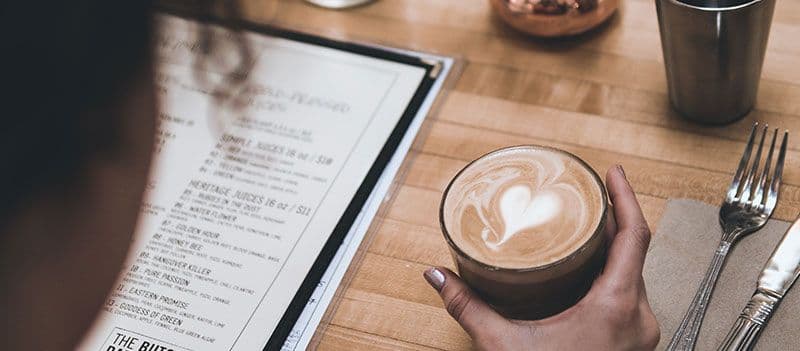A great coffee shop menu is one of your strongest tools to stand out in a busy market and boost profits. Knowing what to include and how to design an effective one can make a huge difference in your business’s success.
What to include in a menu for your coffee shop?
Your coffee shop menu does more than show customers your offerings. It helps them find the taste that they’re looking for and reflects your brand’s unique personality.
Take note that creating a focused menu differs for cafes and coffee shops. Coffee shops focus mainly on coffee and quick bites, while cafes often have bigger kitchens and serve full meals like sandwiches, salads, and brunch plates.
Your menu strategy should align with your specific business model. For coffee shops, focus on core offerings, snacks and bites, and a few alternative options for customers with dietary restrictions or preferences.
1. Core offerings (espresso and other cold or hot drinks)
You’ll need a strong selection of espresso-based drinks. Lattes, cappuccinos, and Americanos made with rich coffee blends are customer favorites. A double-shot espresso latte with steamed milk might be simple, but it gives people that extra energy boost they’re looking for.
Stand out by creating signature drinks, like new house blends. Signature drinks help your brand feel special and give customers a reason to visit your coffee shop over the competition.
Aside from drinks served in-house, Kaldi’s Coffee has also built a loyal following with its coffee beans. It has specialty blends and single-origin offerings that customers can brew at home, allowing coffee lovers to further customize their favorite roasts.
2. Snacks and bites (sandwiches, cookies, and more)
You should also offer food that complements your brews. Freshly baked goods like croissants, muffins, and scones are always customer favorites. A corn muffin or cookies displayed by the register can encourage impulse buys, a simple way to grow food sales without extra work.
For busier mornings, you can offer light breakfast options. Things like bagels with cream cheese, turkey bacon, and egg breakfast sandwiches, or a cheese omelette wrap, can satisfy customers looking for something quick but filling.
At lunchtime, think about grab-and-go lunch choices. Tuna salad, chicken wraps, salmon bowls with lettuce, spinach, and tomato, or even beef paninis can round out your cafe menu.
Pavement Coffeehouse has done this perfectly. They’re known for both their quality coffee and their hand-rolled bagels, allowing guests to grab a bagel sandwich and a cup of coffee.
You can even develop coffee cakes and ice cream, which 61% and 54% of American customers enjoy.
3. Alternative options
Adding alternative options can help you attract a wider crowd and keep them coming back. Dairy-free milk options, like oat, almond, and soy milk, are must-haves.
Other alternatives to consider are gluten-free pastries and sugar-free syrups. By offering a range of alternatives, you can attract customers who feel limited by traditional coffee shop menus.
How to design a great coffee shop menu
Good menu design makes it easy for customers to order fast and feel good about their choices. It also helps highlight your best items and boost profits without making customers feel rushed or overwhelmed.
1. Keep it short and sweet
Having too many items can overwhelm your customers and slow down decision-making. The key is to limit the total number of menu items.
Stick to what you do best. Focus on your fresh coffee, best-selling espresso drinks, and top food pairings like breakfast sandwiches, tuna salad wraps, or cookies.
A smaller menu also helps your staff work faster and more accurately, which improves the whole customer experience, especially during the busy morning rush.
Black Rock Coffee Bar keeps its physical menu simple, displaying only essential information that customers need to order their drinks, like flavors, price, and size.
2. Organize by category
How you organize your coffee shop menu matters just as much as what’s on it. Proper menu engineering helps you guide customers to high-margin options so that you can increase overall profitability.
Group similar items together, such as hot drinks, cold drinks, espresso-based beverages, and food options. Use clear, visually appealing sections that make navigation intuitive.
Black Rock Coffee’s digital menu has clear sections showcasing classic, coffeeless, and chiller drinks. Making it easy for customers to jump to the part of the menu they want.
3. Make pricing simple and transparent
Keep your pricing easy to understand. Make extra charges for things like oat milk or flavor shots clear up front, so guests know how much they can expect to spend for a customized drink. Transparent pricing builds trust and prevents customer frustration.
Black Rock Coffee Bar applies the same strategy. Aside from placing the price prominently beside the size, it also displays how much each additional syrup, sauce, shot, and premium milk costs.
4. Use branding elements
Your menu should feel like a natural part of your coffee shop decor. Pick fonts that match your coffee shop’s style. A sleek, modern cafe might use clean, bold text. A cozy, rustic shop might choose handwritten or vintage fonts.
The same goes for colors. Soft neutrals give a calm vibe, while bold, bright colors can make your space feel fun and energetic.
The Human Bean uses bright colors, playful fonts, and a quirky style across its in-store and online menu. Their design matches the friendly, upbeat feel of their brand.
5. Include photos (but use them wisely)
Photos can be a powerful tool for your coffee shop menu if used the right way. Remember, more isn’t always better.
Too many photos can make your menu look cluttered and confusing. Instead, focus on a few hero shots of your best-selling or signature items. Make sure you check the quality of the images and print to show off the care you put into your food.
6. Think about accessibility
Choose easy-to-read fonts without fancy curls or thin lines. Make sure the text is large enough so customers don’t have to squint.
Good contrast matters, too. Dark text on a light background or vice versa is best. Additionally, avoid putting text over busy images or colorful patterns.
Showcasing your coffee offerings with a winning menu
From offering the right core drinks and fresh food to designing a menu that’s easy to read and true to your brand, every detail counts. With a little planning and the right approach, you can turn your menu into one of your biggest business assets.
Running a busy coffee shop or cafe takes more than a great menu. It takes a great team, too. Using cafe and coffee shop employee scheduling software simplifies assigning and managing shifts, keeping your team working in sync.

Rebecca Hebert, Sales Development Representative
Rebecca Hebert
Sales Development Representative
Rebecca Hebert is a former restaurant industry professional with nearly 20 years of hands-on experience leading teams in fast-paced hospitality environments. Rebecca brings that firsthand knowledge to the tech side of the industry, helping restaurants streamline their operations with purpose-built workforce management solutions. As an active contributor to expansion efforts, she’s passionate about empowering restaurateurs with tools that genuinely support their day-to-day operations.
